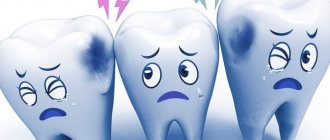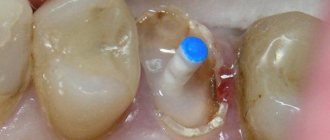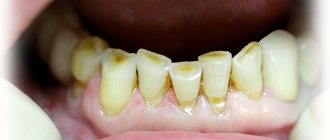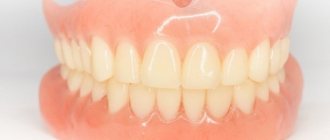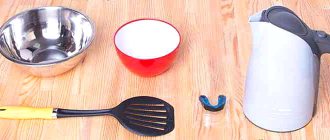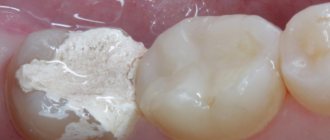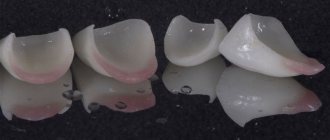The teeth used to be white, but now their color is closer to yellowish. Or the darkening is noticeable only in the root area, near the gums. Or you have never had a snow-white smile, but you dream of getting it... Why does the color of enamel deteriorate, and how to choose the color correction method that suits best?
Coffee negatively affects the color of enamel, but the aesthetic appearance of your smile can be restored
First of all, you need to determine why the enamel color is far from the desired one.
What determines the color of teeth
It is believed that the color of the enamel determines the color of a person’s teeth, but in fact this is not entirely true. Tooth enamel can be milky white and translucent. Initially, in young people, it is quite dense and almost does not show through the underlying dentin, which in turn has a yellow, grayish or yellow-brown tint. The thicker the enamel, the whiter the teeth. The converse is also true.
Over the course of a person's life, the enamel becomes thinner and the color of the dentin appears. Hence the yellow or grayish smiles of older people. Food, drinks and tobacco also contribute to the darkening of teeth. Don’t forget about dental plaque and tartar, which absorb pigments much more strongly than enamel due to their porous structure.
A sudden change in the color of one or more teeth may indicate the presence of a disease. Thus, with fluorosis, teeth may acquire a brownish tint with whitish spots or stripes. Gray color occurs in pulpless teeth or may indicate heavy metal poisoning.
The procedure for tasting wines through the eyes of dentists
During tastings, we are used to alternating wines in this order: first sparkling wines, then still whites, roses and finally red wines. From a dental point of view, this is incorrect and harmful to the color of teeth. Wine has low pH values, with white and sparkling wines having a lower pH than red ones. When white wine hits the surface of the teeth, wines with a lower pH value begin the process of erosion, the tooth becomes more porous, and then red wine stains the teeth more. Based on this, taking into account the difference in pH between wines, you should drink red wines first, and then white and finally sparkling wines. In this order, we will be more careful about the color of our teeth.
How to keep your teeth white
To keep your teeth white, you need to:
- Perform good oral hygiene, including brushing, flossing, and using mouth rinse
- Using a waterpik at least twice a week to get rid of plaque
- Once or twice a year, have your mouth professionally cleaned by a dental hygienist to remove tartar.
- Limit or eliminate smoking, strong tea and coffee
It is also important to make regular visits to the dentist for diagnostic procedures. This will allow timely identification of problems and identification of deterioration of the enamel.
How to keep teeth white for a long time?
Table of contents
- Features of daily dental care after whitening
- How to keep teeth white after whitening
- What is the “white diet”?
- Foods that promote whiter teeth
- Advantages of contacting MEDSI
The natural white color of teeth is a true gift of nature.
Only about 5% of the world's population has it. It is not surprising that other people have to make some efforts to achieve a snow-white smile. Moreover, proper care often requires significant expenditure of both time and effort, as well as money. How to keep teeth white for a long time? How can you maintain oral health? Let's look into these issues.
Features of daily dental care after whitening
All procedures can be divided into 2 main groups:
- Cleansing from plaque. Various studies have proven that within 4–6 hours after brushing, soft plaque is deposited in the oral cavity. If it is not removed, it quickly accumulates and hardens. Multiplying microorganisms release toxins and acids. This leads to the fact that teeth not only lose their shine and whiteness, but also become a site for the development of infections and inflammatory processes. For this reason, it is very important to perform hygiene not only efficiently, but also regularly.
- Restoring enamel using specialized pastes. 95% of teeth consist of strong phosphorus and calcium mineral complexes. The remainder is water and organic matter. In healthy teeth, processes of demineralization and remineralization of teeth constantly occur. If you do not regularly use pastes with calcium, phosphorus and other valuable substances, the first process begins to prevail over the second. This leads to the fact that the tooth enamel loses not only its original color, but also its health and is gradually destroyed. To prevent this, you need to use special products recommended by your dentist. The specialist will select a paste with the optimal composition for a particular patient.
How to keep teeth white after whitening
You should understand the importance of not only the regularity of care, but also its quality. Oral hygiene after the procedure should be more thorough.
Proper cleaning includes:
- A certain duration. Morning and evening hygiene should last 2–3 minutes
- Use a toothbrush with medium-hard bristles. The soft one most likely will not remove all deposits, while the hard one can harm not only the enamel, but also the gums and mucous membranes.
- Using dental floss. Only she can clean the interdental spaces well. You can also use an irrigator. A directed jet of water or a special product will remove all contaminants.
- Using rinse aid. It will also help improve hygiene
Important! Professional cleaning should not be neglected. It should be carried out once every six months. A simple procedure will prevent the formation of hard deposits, the development of caries and other pathological conditions.
What is the “white diet”?
It is this, according to many experts, that allows you to maintain the natural whiteness of your teeth. This diet involves eating certain foods. You should stick to it for several days after the whitening procedure.
It will be necessary to exclude from the diet:
- bright berries, vegetables and fruits
- red wine
- carbonated drinks with dyes
- chocolate
- tea and coffee
- juices
- smoked meats
- spices and sauces
- quick soups
The dentist will announce a complete list of foods and drinks prohibited for consumption.
Foods that promote whiter teeth
In order to correctly create the right diet, you need to understand that some foods contribute not only to the destruction of enamel, but also to its coloring. These products mainly include sweets and baked goods, colored carbonated drinks, pickles and marinades with various acids, etc.
It is important to understand what determines the whiteness of teeth. It is determined not only by bad habits and age factors, but also by what we eat and drink every day.
For example, teeth whitening is promoted by:
- chicken and white meat fish
- cabbage
- White mushrooms
- soy and rice
- walnuts
- green pears and apples
- dairy products
- tofu cheese
- wheat bread
As you noticed, some of the products can be harmful to dental health, so you should not overuse them. If you want to not only lighten the enamel, but also make it as strong as possible, you need to give preference to fresh hard fruits and vegetables (cabbage, apples, broccoli), nuts, and dairy products with a high calcium content (cottage cheese, hard cheese).
Advantages of contacting MEDSI
- Opportunities for high-quality teeth whitening.
As a result of the procedure, the enamel can be lightened by 8–10 tones. - Gentle techniques and materials.
Thanks to them, the preservation of dental health is ensured and increased sensitivity of the enamel after whitening is eliminated. - Modern systems.
We give preference to ZOOM-4 technology, which has proven itself in all progressive countries of the world and allows you to achieve shine and whiteness of teeth
To clarify the conditions for the procedure and make an appointment, just call +7 (495) 7-800-500. Our specialist will answer all questions. Recording is also possible through the SmartMed application.
Teeth whitening and restoration techniques
If even careful care and regular professional hygiene do not allow you to completely get rid of yellowness, teeth whitening comes to the rescue. In our articles, we have already examined in detail the advantages and disadvantages of office and home whitening.
When darkening of the teeth is caused by severe thinning of the enamel, dental disease, or a general deterioration in the patient’s health, the first step is to correctly diagnose the problem and carry out appropriate treatment. Afterwards, it is possible to restore your smile with the help of veneers, lumineers and crowns.
We recommend that you try your best to keep your teeth healthy.
What are the ways to solve the problem?
Let's compare several main ways to correct the appearance of teeth.
| Problem | Solution |
| The enamel is naturally yellow or yellowed with age. | Teeth whitening in the clinic. This procedure can lighten teeth several shades, it is quick (30 minutes) and does not harm the teeth. Whitening should be repeated approximately once every 6 months. Home whitening products are less effective; results can only be achieved at home in 10–14 days and are likely to be less noticeable than in a clinic. Veneers can radically solve the problem and make teeth perfectly white. |
| Fluorosis | This is a damage to the enamel structure itself, and not to the surface layer. Minor fluorosis can be sanded down and then coated with fluoride varnish. Severe fluorosis cannot be completely removed; in this case, it is recommended to install aesthetic fillings or veneers. |
| Plaque or tartar | Soft plaque, which cannot be cleaned with a regular brush, can be easily and quickly removed in the clinic using Air Flow (treatment with a jet of water-soda solution under pressure). If the plaque has mineralized and turned into stone, it can be removed using ultrasonic cleaning. These two procedures are not interchangeable, they are needed for different purposes and are usually used sequentially in one appointment. After which the natural color of the enamel returns. |
| Darkening due to tea, coffee, smoking | In this case, a combination of procedures will help: ultrasonic cleaning, Air Flow and whitening. To avoid irritating the gums, it is better to carry out whitening not on the same day as brushing, but later. How often the procedure will have to be repeated to maintain the color depends on whether the habits are maintained. But on average, the result lasts from 6 to 12 months. |
| Darkening due to medication | This is a defect that cannot be removed by cleaning - darkening is associated with changes in the deep layers of enamel. Therefore, only veneers or crowns can give your teeth an ideal look. |
As can be seen from the comparison, there is no universal recipe. For aesthetic technology to be effective, you need to correctly assess the cause of the problem - for this it is best to consult a dentist.
Other articles:
- Can veneers correct crooked teeth?
- Aesthetic dentistry and its possibilities
Diet after teeth whitening
The purpose of the white diet is to protect weakened tooth enamel from exposure to chromogenic (stain-causing) and destructive substances until it is completely restored. During this period, the patient's diet should be rich in protein foods, microelements and vitamins that promote the rapid restoration of hard dental tissues (fluoride and calcium are especially important). The recommended timing for the white diet is as follows:
- For the first three days, the patient adheres to strict restrictions. These days, the enamel is especially vulnerable, and its porous structure is susceptible to the penetration of foreign substances.
- Over the next two weeks, the list of permitted products will expand. The minerals contained in food, necessary for the restoration of dentin, are gradually integrated into its tissue and strengthen it.
An ideal smile is not only snow-white teeth, but also a correct bite, as well as an even, beautiful dentition. The specialists of the Consilium Dent clinic will help solve all these problems and make your smile irresistible.
Using a scale to determine the whiteness of teeth
The Vita scale is a small, easy-to-use rod with samples attached to it. Plastic, paper or cardboard are used for manufacturing, but ceramics are considered the best option. Dental porcelain conveys color better than others; its reflective properties are as close as possible to enamel and make it easier to select the desired tone.
On the scale, all shades are collected into four main groups:
- A – reddish-brown shades;
- B – colors with a yellow-red tone;
- C – gray tones;
- D – group with grayish-reddish tones.
Each group includes subgroups with tones from 1 to 4, which makes selection easier and more accurate. The whitest color on this scale will be A1, the darkest color D4. The use of such a scale is required in the following cases:
- installation of light seals, including for the frontal area;
- with classical prosthetics;
- when choosing a shade for veneers, microprostheses of other types;
- during whitening (to predict the result and control the achieved effect).
Using the Vitascale standard is quite simple, but maximum attention is required from the doctor. The dentist applies the scale to the surface of the dentition and selects the shade in accordance with the samples. The required group is determined first, then the subgroup with the most accurate shade is determined.
What to eat after whitening
A colorless diet is based on foods that have a low risk of staining the enamel. Your diet should include more protein foods and foods rich in calcium and fluoride. Here is the full list of permitted products:
- milk and dairy products, yogurt without dyes, cottage cheese and sour cream, light cheeses;
- white meat (turkey, chicken breast, rabbit);
- white fish (cod, hake, pollock, flounder), shrimp, squid, mussels;
- egg white;
- pasta, white bread, oatmeal and rice, white beans;
- champignons, porcini mushrooms;
- potatoes, cabbage, zucchini, cucumbers, white onions, garlic;
- green apples, pears, melon, bananas, grapes;
- clear broths, clean water, uncolored drinks.
During this period, it is recommended to steam, boil, stew or bake in the oven. Dishes made from minced meat, omelettes, salads, cereals, purees, soft baked goods will be useful.
What prohibitions exist after the whitening procedure?
During the white diet, all bright foods and drinks are prohibited. Among them:
- coffee, cocoa, black tea, red wine, juices, fruit drinks;
- carbonated drinks, lemonade, champagne, red wine;
- chocolate, preserves, jams, brightly colored sweets;
- black bread, sweet pastries;
- spices, mayonnaise, ketchup, products containing vinegar, adjika, mustard, colored spices;
- tomatoes, carrots, beets, hot peppers;
- cherries, currants, mulberries, citrus fruits, blackberries, prunes, blueberries;
- green onions, dill, parsley, basil, lettuce.
During this period, you should not eat foods that injure the enamel. These include all spicy, salty, sour, and too hard foods. Hot and cold foods are also prohibited, since temperature changes during this period are undesirable.
To better preserve the enamel, doctors recommend following a gentle diet a week before the procedure. Then, during the procedure, the enamel will suffer less, and the recovery period will be shorter.
White diet
The first thing to start with is following a white or colorless diet. You should follow this diet for the first couple of weeks after the procedure. A colorless diet is a diet in which the diet excludes foods with dyes.
Main foods that can be consumed during the diet:
- potato;
- white meat and fish;
- white cereals;
- White mushrooms;
- dairy products;
- cheese;
- bakery products;
- walnuts;
- green apples and pears.
After the procedure itself, for the first couple of days you need to avoid coloring foods that can harm the whiteness of your smile:
- tea and coffee;
- red wine;
- juices and fruit drinks;
- colored lemonades;
- chocolate;
- fruits and berries;
- tomatoes, beets, carrots;
- ketchup, adjika, all sauces.
You can start introducing tea and coffee into your diet a couple of days after the procedure. At the same time, it is better to drink them through a straw and at first you should limit yourself to one cup of the drink per day. Other coloring foods should be excluded from the diet for the first few weeks after bleaching. It is also better not to eat acidic foods, which can cause discomfort, since the enamel is very sensitive after whitening.
If suddenly some prohibited product gets into your diet, after eating it you need to immediately brush your teeth or use a mouth rinse to remove pigmentation from the enamel.
Every diet, even white, has its pros and cons.
Pros:
- maintaining the whiteness of tooth enamel;
- strengthening enamel (foods included in the diet are rich in calcium and protein);
- diet promotes weight loss;
- The consumption of coloring foods and drinks is minimized.
Minuses:
- the list of foods and drinks allowed for consumption is very limited;
- The diet must be followed for several weeks after whitening.
Failure to follow a diet will quickly return your teeth to their original color.
A transparent diet has a positive effect not only on the color of teeth, but also on the health of the patient’s body as a whole.

